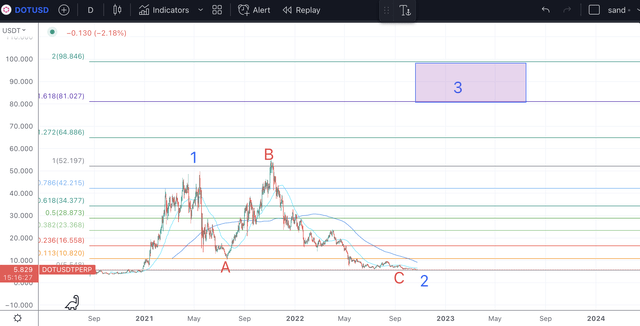salarko
Overview
Polkadot (DOT-USD), the blockchain focused on interoperability, has seen a steady increase in development activities, according to data obtained from Santiment. Polkadot’s GitHub saw over 500 contributions each day in September; reaching a new all-time high of daily contributions in a month. In August, there were 14,930 contributions on Polkadot’s GitHub. Polkadot brings together a network of heterogeneous blockchains called parachains.
Parachains in Polkadot are individual Layer-1 blockchains that run in parallel, connected to the Polkadot relay chain. Some popular blockchain networks, including KILT Protocol, Acala, and Astar, run as parachains on Polkadot. KILT protocol recently became the first parachain to fully migrate from the Kusama network to Polkadot’s relay chain. Projects building on Polkadot start their development on Kusama, Polkadot’s “canary” network. Kusama can be likened to pre-production, experimental environment where teams can deploy and stress-test new technologies.
To become a parachain on Polkadot, Layer-1 projects bid for a parachain slot, as Polkadot’s parachain slots are currently limited – estimated to be around one hundred available slots. Parachain slots are assigned in an on-chain auction. Projects that win a parachain auction bid are required to lock up a substantial amount of DOT, Polkadot’s native token, for the duration of the parachain slot lease.
Parachains on Polkadot communicate (or work in parallel) using Polkadot’s Cross-Consensus Message (XCM) format. XCM allows parachains to natively interoperate with each other, enabling cross-blockchain transfers of any type of data or asset. Data from Subscan, Polkadot’s explorer, reveal that 26,258 messages were exchanged between Polkadot’s parachains in September; this is an all-time high number of messages exchanged between parachains in a month. Over 140,000 messages have been exchanged between parachains on Polkadot since the network launched. Polkadot has also seen an increase in the number of parachains launching on Kusama.
Polkadot New Roadmap
Polkadot’s new roadmap touches on upcoming improvements in scalability, governance, cross-chain bridges, and staking, among others. Some of the eye-catching improvements laid out in the roadmap include:
Governance Overhaul
Polkadot’s governance system is set to get an overhaul. An update will remove the council and technical committees, introduce the Polkadot Fellowship, and move every decision to a community referendum. The new governance system is to be rolled out in Kusama in early Q4 2022 after a vote and approval from token holders.
Introduction of Parathreads
Parathreads will make launching blockchain networks on Polkadot easier and less expensive. Parathreads will use a pay-as-you-go model. Normally, when projects bid for a parachain slot, they are required to lock up a substantial amount of DOT. With the introduction of Parathreads, blockchain networks could be launched on Polkadot with the ease of creating a smart contract. Parathread blocks will possess the same level of security as Parachain blocks. Parathreads are expected to go live on Polkadot in Q1/Q2, 2023.
Cross-Consensus Messaging Version 3 (XCMv3)
XCMv3 will be an upgrade to the current XCM format used inside or outside the Polkadot ecosystem for communication among different chains. XCMv3 will give parachains and applications and contracts deployed on parachains support for bridging to external networks and APIs for querying and invoking pallets on other chains. XCMv3 will unlock the capability to bring external tokens into Polkadot and the ability to pay fees between chains and in any token, among others. Polkadot aims to deploy XCMv3 by the end of the year 2022.
Scalability via Asynchronous Backing
When implemented, Asynchronous Backing will reduce the parachains’ block time to 6 seconds; at the moment, the parachain block time is 12 seconds. Asynchronous Backing will also increase the amount of block space available by a factor of 5-10; this will make blocks bigger and more data could be sent to the relay chain leading to lower latency and faster finality for transactions executed on parachains. Parachains will also be able to “reuse” blocks if the block does not get to the relay chain on the first attempt. Polkadot estimates that the Asynchronous Backing upgrade will increase its Transactions Per Second (“TPS”) to a value between 100,000 and 1,000,000 without compromising the network’s security.
Updates to Staking and a New Dashboard
Polkadot says it is moving towards a future of full proof-of-stake (“PoS”) blockchain by actively working to “super scale the PoS system” and the introduction of nomination pools. These “pools” will be permissionless and created by users and will allow other users to join and stake; this will enable more nominators, especially smaller ones, to join the staking system. Pools have been live on Kusama since June and have gone through tests and experiments, with 64 pools created so far.
Polkadot also aims to ease the complexity of staking in its ecosystem by providing an intuitive, user-friendly dashboard for staking. Parity technologies, Polkadot builder, has built the Staking Dashboard, which is currently in open beta but is already feature-complete and can be used.
Polkadot is a very technical project; even the user interface of one of its most popular wallets, polkadot.js, can be tedious to navigate for a crypto newbie. Introducing intuitive, user-friendly interfaces and dashboard is a step in the right direction for Polkadot.
Technical Analysis
Polkadot Price Analysis (Author’s work)
The way I see it, Polkadot completed wave 1 in May of 2021, and since then, we have been in an ABC correction. With the latest moves, we have enough to count five waves down for C, and I am not watching for an initial sign of a turnaround. Once a change in trend is confirmed, we can say that we are in wave 3, which should reach at least the 1.618 ext at $81, but could go above $100. Of course, we need Polkadot to hold this recent low.
Risks
Though there is a lot to like about Polkadot, there are some risks we have to consider. For starters, Polkadot competes with numerous L1 blockchains that have fast and cheap transactions. However, my biggest concern with Polkadot is that the way parachains are auctioned could limit the activity and adoption of the blockchain. These auctions are expensive, and many smaller projects cannot afford to operate in Polkadot.
Takeaway
Polkadot is one of the blockchain networks working rigorously to solve the Blockchain Trilemma. As its new roadmap reveals, there are planned upgrades that touch on decentralization, scalability, and security. For the past couple of months, DOT has not seen a price action that is reflective of Polkadot’s high development activities; it is worth noting that we are still in a bear market.
Polkadot’s development activity could give DOT the needed resuscitation as the upgrades get rolled out in the coming months. Being active and constantly building in a bear market is a sure-fire way to become a leading blockchain project. Polkadot’s monthly developer activities for September surpassed even Ethereum, Near Protocol and Solana’s – a big feat and one that I believe will surely pay off in the long term.


Be the first to comment